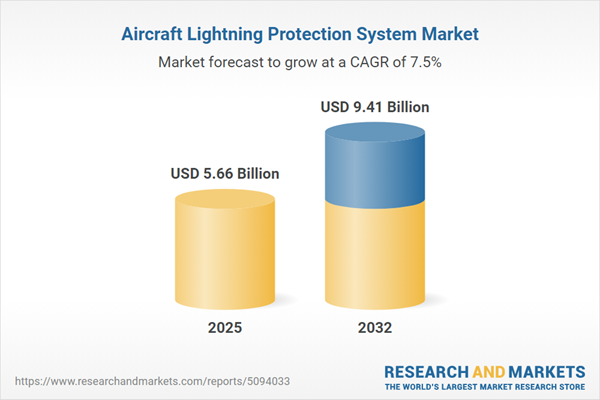Speak directly to the analyst to clarify any post sales queries you may have.
Senior aviation executives are turning attention toward advanced aircraft lightning protection system solutions to enhance compliance, ensure consistent fleet operations, and bolster supply chain adaptability in a rapidly changing environment.
Market Snapshot: Aircraft Lightning Protection System Market
The global Aircraft Lightning Protection System Market stands at USD 5.26 billion in 2024 and is projected to grow to USD 5.66 billion in 2025, ultimately reaching USD 9.41 billion by 2032. This steady market expansion is driven by ongoing advances in lightning protection technology, a consistent regulatory focus, and the integration of high-performance materials. Increased adoption of composite airframes and stringent global safety protocols are resulting in heightened demand, especially in commercial aviation, defense, and UAV sectors. Established providers differentiate through innovation tailored to changing compliance needs and operational expectations across aviation markets.
Scope & Segmentation
This report delivers strategic analysis tailored for senior leaders responsible for procurement, engineering, and risk management in aviation. It covers a comprehensive range of segments, technologies, and regional variations influencing market direction.
- Protection Types: Includes both active and passive lightning protection, enabling customized risk management approaches for differing operational environments worldwide.
- Component Types: Covers bonding jumpers, gas discharge tubes, dissipater wicks, spark gaps, cables, connectors, and transient voltage suppressors, all essential for protecting critical electronics and avionics systems.
- Platform Types: Designed for integration into fixed wing and rotary wing aircraft, spanning commercial, military, and unmanned platforms to address varied operational needs.
- Material Types: Comprises composites, specialty coatings, engineered mesh, foils, and metals, supporting both evolving and legacy airframe constructions.
- Aircraft Types: Adaptable solutions for business jets, airliners, military aircraft, and UAVs, ensuring broad platform compatibility.
- Installation Types: Reflects OEM installations as well as aftermarket retrofit capabilities, essential for supporting both new fleet builds and ongoing operational upgrades.
- Distribution Channels: Utilizes direct partnerships and multi-tier distribution, enhancing supply chain efficiency and responsiveness worldwide.
- Regional Coverage: Encompasses the Americas, Europe, Middle East, Africa, and Asia-Pacific, reflecting diverse regulatory, operational, and adoption profiles globally.
- Leading Companies: Features industry participants such as Honeywell International Inc., Raytheon Technologies Corporation, Parker-Hannifin Corporation, Eaton Corporation plc, Safran S.A., TE Connectivity Ltd., Carlisle Companies, Triumph Group, Amphenol Corporation, and Ametek, Inc., each advancing industry standards and innovation.
Key Takeaways for Senior Decision-Makers
- Adopting predictive maintenance strategies positions fleets for more proactive risk management, resulting in stronger operational stability and lower unplanned downtime.
- Implementing both active and passive lightning protection approaches allows operators to adapt systems to specific geographic climates, regulatory pressures, and risk profiles.
- Initiating the certification process early in procurement improves regulatory alignment and accelerates aircraft readiness for commercial deployment.
- Harmonizing maintenance and compliance protocols with emerging international standards supports smoother cross-border operations while reducing regulatory exposure.
- Reinforcing supplier relationships and implementing digital manufacturing solutions streamlines asset management and supports sustainable long-term maintenance planning.
- Optimizing procurement processes and leveraging specialist resources underpin compliance and operational readiness for varied aircraft classes and mission requirements.
Tariff Impact: Navigating U.S. Policy and Supply Chain Disruption
Shifts in U.S. trade policy concerning lightning protection system components have resulted in increased domestic manufacturing and closer supplier partnerships. Companies are responding by strengthening supply chain oversight and collaborating more closely with regulatory bodies, which enhances both product reliability and operational continuity. These measures are helping mitigate disruptions caused by ongoing global trade uncertainty.
Methodology & Data Sources
The analysis integrates technical evaluation, regulatory assessment, patent studies, and input from industry experts. This approach is supported by benchmark and field data to validate findings and provide actionable recommendations for leadership in fleet risk and regulatory strategy.
Why This Report Matters
- Presents an actionable structure for managing volatility in the aircraft lightning protection system market and optimizing procurement and supply chain processes.
- Supplies practical guidance for evaluating and implementing advanced lightning protection technologies while maintaining robust compliance strategies across regulatory environments.
- Supports confident supplier selection and system deployment for evolving aircraft fleets, with emphasis on certification and lifecycle support.
Conclusion
Strategic investment in modern lightning protection systems and comprehensive oversight help operators maintain fleet resilience and consistently meet changing industry standards and compliance requirements.
Additional Product Information:
- Purchase of this report includes 1 year online access with quarterly updates.
- This report can be updated on request. Please contact our Customer Experience team using the Ask a Question widget on our website.
Table of Contents
3. Executive Summary
4. Market Overview
7. Cumulative Impact of Artificial Intelligence 2025
Companies Mentioned
The companies profiled in this Aircraft Lightning Protection System market report include:- Honeywell International Inc.
- Raytheon Technologies Corporation
- Parker-Hannifin Corporation
- Eaton Corporation plc
- Safran S.A.
- TE Connectivity Ltd.
- Carlisle Companies, Inc.
- Triumph Group, Inc.
- Amphenol Corporation
- Ametek, Inc.
Table Information
| Report Attribute | Details |
|---|---|
| No. of Pages | 185 |
| Published | October 2025 |
| Forecast Period | 2025 - 2032 |
| Estimated Market Value ( USD | $ 5.66 Billion |
| Forecasted Market Value ( USD | $ 9.41 Billion |
| Compound Annual Growth Rate | 7.5% |
| Regions Covered | Global |
| No. of Companies Mentioned | 11 |









